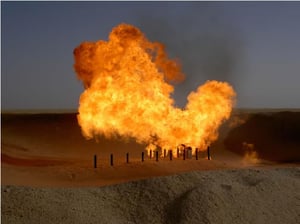BACK TO TECHNICAL PAPERS
By Marriott Waikoloa on October 22, 2007
ISIS-3D General Comments
- Based on Computational Fluid Dynamics with radiative heat transfer and combustion chemistry
- Linked model is capable of simulating complex, three-dimensional objects engulfed in fires
- Provide reasonably accurate estimates of the total heat transfer to objects from large fires
- Predict general characteristics of temperature distribution in object
- Accurately assess impact of variety of risk scenarios (wind, % flame coverage, thermal fatigue for given geometry, etc.)
- Reasonable CPU time requirements on “standard” desktop LINUX workstation

Approach to Modeling Full Flare Fields
- Model Single Burner Test
- Perform Calibration Tests
- Calibrate Soot Yield and Reaction Parameters for Test Fuel
- Predict flame shape and size
- Model Multi-Burner Test
- Perform Radiation Calibration Tests
- Check Tip/Row Spacing
- Predict flame shape and size
- Model Full Flare Field
- Use Calibrated Soot Yield and Radiation Models
- Predict Flare Performance (Smoke Production/Air Demand)
- Predict Radiation Load on Wind Fence
Conclusions
- ISIS-3D Model:
- Single-burner model used 110,000 cells
- Three-burner model used 188,000 cells
- Full-field model used 700,000 cells (Sustained Flow)
- 1,200,000 cell (Peak Flow)
- Combustion chemistry for propane, ethylene, mixed gas
- Modeled flame shape/size for 3 fuels for single and three burner tests
- Predictions compared to data from 12 tests (2 tip sizes, 3 operating pressures, 2 radiation sample locations)
- Predicted “reasonable” estimates of radiation heat transfer and air demand for low profile flare
- Air/fuel ratios range from 28 to 47 for 3-burner test and from 37 (Peak Flow Case) to 51 (Sustained Flow Case)
- Calibrated flare model applied to full-flare field to estimate:
- Air demand for specified tip/row spacing
- Radiation load on wind fence for nominal and peak flow cases
- Expected flame height and smoke production for nominal and peak flow cases
Download Technical Paper
BACK TO TECHNICAL PAPERS